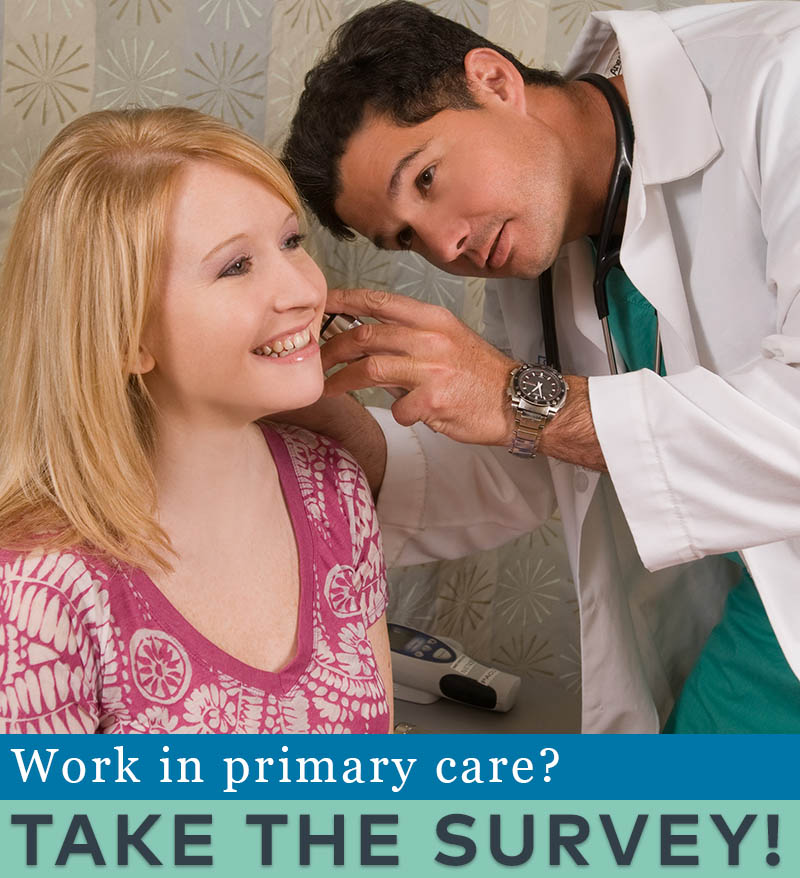For data from the previous clinician survey, see Round 34 Results.
The Primary Care Collaborative has partnered with the Larry A. Green Center to regularly survey primary care clinicians and patients to better understand the impact of COVID-19 in real time.
Who replied to the survey in round 35?
Responses came from 847 clinicians in 49 states and Washington, D.C.
Specialties: 63% family medicine, 11% internal medicine, 18% pediatrics, 3% geriatrics, 5% other
Type: 73% MDs, 6% DOs, 11% NPs, 4% PAs, 5% other
Settings: 28% community health centers or similar, 19% rural, 17% residencies
Practice size: 27% had 1-3 clinicians, 42% had more than 10 clinicians
Ownership: 28% self-owned, 42% system-owned, 6% government-owned, 4% membership-based
The survey was conducted February 25-March 1, 2022
Results at a glance
- Two years into the pandemic, primary care practices—those still open—continue to feel the strain of COVID-19. Close to half (>46%) say that “U.S. primary care is crumbling.” Only a fifth of clinicians report that their practice is fully staffed, with 68% saying they have open staff positions that cannot be filled. 29% say they have personal knowledge of practices that have closed during the pandemic. And a majority (52%) report that their practice staffing ratios have changed to fewer staff per clinician.
- Clinician burnout remains strikingly high. Despite the development of COVID vaccines, better testing, and reopened doors, primary care clinicians continue to experience high levels of stress and fatigue. Over a third (36%) still say their level of burnout is at an all-time high, and over half (53%) say their ability to bounce back and/or adjust to adversity has become limited. Two-thirds (62%) have personal knowledge of clinicians who have retired early or quit during the pandemic.
- Patients are flooding into clinics, many with unmet needs. 40% of respondents say they are "flooded to overwhelmed" by patient needs. This may be, in part, due to patients needing to find new sites of care: 40% of clinicians report getting more new patients because of practice closures. And nearly 60% of respondents say that patient visits take longer than they used to because of unresolved or exacerbated concerns from delayed access to care during the pandemic.
- Primary care is adapting to meet patients’ needs in new and creative ways. Close to half (47%) of all respondents report adding or extending services not usually provided in order to prevent patients’ use of hospital or specialty care; 70% say they monitor COVID-19-positive patients at home or in the practice to prevent the use of hospital or specialty care. Notably, 72% of clinicians say they have become more involved in mental health support.
- Telehealth is one of those ways—and is likely here to stay. A quarter (24%) of respondents report relying on telehealth (either phone or video) for at least 30% of patient visits. A big driver of this may be patient preference: nearly half (49%) say they are motivated to use telehealth because their patients really like it. Another factor is reduced staffing. 20% of clinicians say lack of sufficient staffing has caused expanded use of telehealth in their practice.
- Still, barriers to telehealth remain a challenge. Over half (52%) of surveyed clinicians say that computer illiteracy makes it difficult to use telehealth with at least a fifth of their patients. About a third (30%) point to lack of broadband as a barrier for at least a fifth of their patients. And over a quarter (28%) blame insufficient payment as an obstacle that limits their practice’s use of telehealth.
- Primary care practices are playing a role in vaccine distribution, but it could be much bigger. Fewer than half of all respondents (44%) say their state has actively engaged primary care to help with vaccination distribution; and the same low percentage of respondents say patients view their practice as a COVID vaccination site. Well over a year since vaccine distribution began, less than 60% of clinicians report having adequate access to COVID vaccines that meets their needs.
- Overall vaccine hesitancy is on the rise. Primary care clinicians are seeing a decline in the use of vaccines generally, with 32% noticing a “year-over-year reduction in use of general vaccines by our patients” and 22% noticing “a year-over-year reduction in childhood vaccinations delivered at our practice.” Over a quarter (25%) of respondents say they have lost clinicians or staff because of a vaccine mandate in the practice.
- Comprehensive primary care is stepping up. Over 45% of clinicians say either they or their practice spoke publicly on the topic of COVID-19 or volunteered at mass vaccination sites. And they are expanding care to fully meet patients’ needs during the pandemic and beyond: A third of clinicians have increased their support for patients with food or housing insecurities; a quarter (26%) have increased offers of assistance to those with financial insecurity; and another quarter (26%) ask more screening questions about domestic violence and child abuse.
Learn more: Download the Round 35 Clinician Survey Executive Summary (includes select open-ended answers to survey questions)
| Attachment | Size |
|---|---|
| 283.19 KB |

Are you a physician, nurse practitioner, or PA working in primary care?
Help PCC and the Larry A. Green Center track how your practice is responding to the COVID-19 outbreak by completing the Green Center's occasional survey.
The regular surveys are no longer being conducted.
COVID-19 Updates
May 9, 2022 | Primary Care Collaborative
April 19, 2022 | Primary Care Collaborative
April 19, 2022 | Primary Care Collaborative
March 7, 2022 | STAT
February 27, 2022
- 1 of 39
- next ›

Recent News
March 19, 2024
February 28, 2024
February 22, 2024 | Conversations on Health Care
May webinar highlights: “The Commercial Market: Alternative Payment Models for Primary Care” Nate Murray explains w… https://t.co/KX9Wi2w6oY —
10 months 1 week ago
@CMSinnovates’ primary care strategy is rooted in a 2021 @theNASEM’s report which called #primarycare “foundational… https://t.co/glbPxvCysg —
10 months 1 week ago
@CMSinnovates has a new #primarycare strategy, envisioning “ACO-based primary care model tests that may focus on pr… https://t.co/aJGF1z411l —
10 months 1 week ago
- Page 1
- ››
Secondary menu
Copyright © 2024 Primary Care Collaborative




